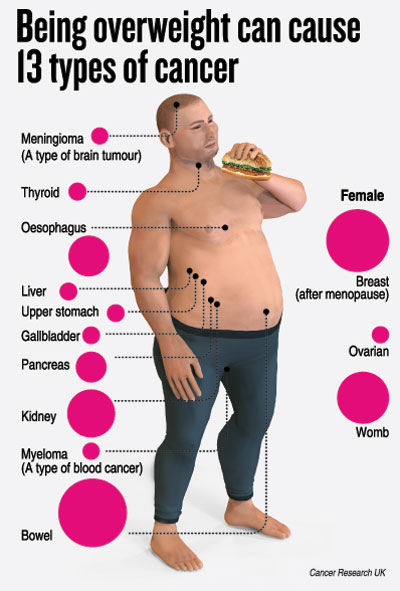Act now: Obesity IS a disease
The myth of it being ‘a sign of prosperity’ has long been debunked with another dangerous red-flag being waved urgently and vigorously.
Thirteen cancers, particularly in women, are being closely linked to obesity, MediScene learns. Along with obesity, the vulnerability for meningioma, thyroid, oesophagus, breast, liver, upper stomach, gallbladder, pancreas, kidney, bowel, ovarian, womb and myeloma rises. (See graphic please)
 “The cancers are in addition to other dangerous diseases and conditions such as diabetes, hypertension, high cholesterol, cardiovascular disease, chronic kidney disease, fatty liver, cirrhosis, back pain, knee problems and sleep apnoea which follow hotly on the heels of being fat and overweight,” reiterates Consultant Endocrinologist & Diabetologist Dr. Prasad Katulanda attached to the University Medical Unit of the National Hospital of Sri Lanka.
“The cancers are in addition to other dangerous diseases and conditions such as diabetes, hypertension, high cholesterol, cardiovascular disease, chronic kidney disease, fatty liver, cirrhosis, back pain, knee problems and sleep apnoea which follow hotly on the heels of being fat and overweight,” reiterates Consultant Endocrinologist & Diabetologist Dr. Prasad Katulanda attached to the University Medical Unit of the National Hospital of Sri Lanka.
Even in cancer survivors, recurrence is high in those who are obese, it is learnt.
Considering the huge disease burden brought on by being obese, the theme of World Obesity Day marked on Wednesday (October 11) was aptly–‘Treat obesity now and avoid the consequences later’.
Underscoring that it is an “emergency situation”, Dr. Katulanda points out that obesity is now very clearly labelled as a disease. However, there are no widespread facilities to tackle and treat obesity.
He provides disturbing statistics of 10 years ago, while pointing out that the data may have jumped higher:
40% of women (4 in 10) were overweight or obese.
30% of men (3 in 10) were overweight or obese.
“These figures could be higher now with our faster and unhealthy pace of life. This is why we need to act right now,” he says to prevent this insidious gathering of fat on our bodies which is the root cause of so many deadly diseases.
Dr. Katulanda is insistent that with obesity being declared a disease, we need a major and prompt change in our thinking. It is no longer saying that a person looks a little plump, should eat a little less and do a little exercise. As the World Obesity Federation suggests it is about mobilizing all forces including the government and private sectors, non-governmental organizations and all medical and other health professionals as well as the public to bring about policy changes as also lifestyle changes.
Policy changes should encompass proper food labelling, what can or cannot be advertised, changes within the working environments to encourage a healthy lifestyle, changes in the school curricula to create awareness and also strict canteen policies, according to Dr. Katulanda, explaining that with obesity being a disease, the treatment of it should be covered by insurance.

Dr. Prasad Katulanda
There are guidelines on food advertising but there should be strong mechanisms for their implementation and follow-up with penalties against those who violate them. Meanwhile, workplaces should encourage employees to spend less time seated, with more walking around, as being sedentary is a major risk factor for obesity and other non-communicable diseases, he says.
Advocating innovative or out-of-the-box thinking, Dr. Katulanda suggests having ‘standing’ meetings and also incentives for staff to get out of their seats and walk around. The transport system should also be geared towards a healthy lifestyle, without long stops both at bus-stands and in traffic which compel commuters to be sedentary.
Adding its voice of concern, the World Obesity Federation based in the United Kingdom states without ambiguity that the obesity epidemic is rapidly becoming the “biggest” public health challenge globally, ranking in the top three causes of chronic ill-health. There are no countries which have turned around the epidemic and there are enormous commercial interests opposed to effective public health policies. In 2014, the global economic impact of obesity was estimated at $2 trillion a year; similar to smoking and war/global conflict. This figure includes the healthcare costs as well as costs associated with lost productivity.
The Federation states that the rise in obesity is generally attributed to people eating more food energy than they need. In many areas of the world, food has become more readily available, attractive and cheaper than ever, at a time when economic development has reduced the need for high levels of physical activity. The World Health Organization set a target to get obesity back to the 2010 levels, as a first step, by 2025.
“But time is ticking – we now have less than eight years to achieve this.”
It can be done, however, says the Federation, giving some ideas:
Commit to adding less/not adding sugar to drinks
Avoid sugar-sweetened beverages
Limit alcohol consumption (hidden calories!)
Aim to eat more fruit and vegetables
Reduce portion size at meals
Be mindful of snacking habits
Go for a daily lunchtime walk
Active travel to/from work
Cycle or walk to work/to the shops
Wear a pedometer
Use the stairs instead of the lift
Join a gym
Set yourself an activity goal
The Federation, representing professional members of the scientific, medical and research communities from more than 50 regional and national obesity associations also warns that on current trends 2.7 billion adults worldwide will suffer from overweight and obesity by 2025.
| Take a good look at your childrenFocusing on children who are closest to our hearts, Dr. Prasad Katulanda is quick to point out that ‘childhood obesity is a vicious circle’. An obese child grows up to be an obese adolescent, an obese youth and an obese adult.“We must and should look at our children closely. Even if they cannot go back to basics like in our childhood of playing for many hours after school and picking fruit from the trees in our gardens and munching on them even without thinking, we need to come up with strategies to curtail this epidemic of obesity,” he says.Looking into schools, he commends the health inspection programme but suggests that the early signs of obesity should also be picked up under it, so that corrective measures can be taken sooner than later. The obvious tell-tale signs will be:Children being on the plump side Breast enlargement and development of neck folds in boys Menstrual delays in girls He gives some simple advice:Not only should parents eat healthy food but make sure that their children do so too, without taking the convenient way out and giving them pocket money to buy junk food. Parents should ensure that children eat lots and lots of green vegetables and fruit. Children should also have at least 60 minutes or more of physical activity every day, in this day and age when they are always glued to the television or the computer. “Don’t over-feed or force-feed babies and children,” he says, adding that those days in the villages because food may have been scarce, parents would have kept on feeding whatever was available in their homes to children. But now that scenario has changed and food is aplenty.
| |


